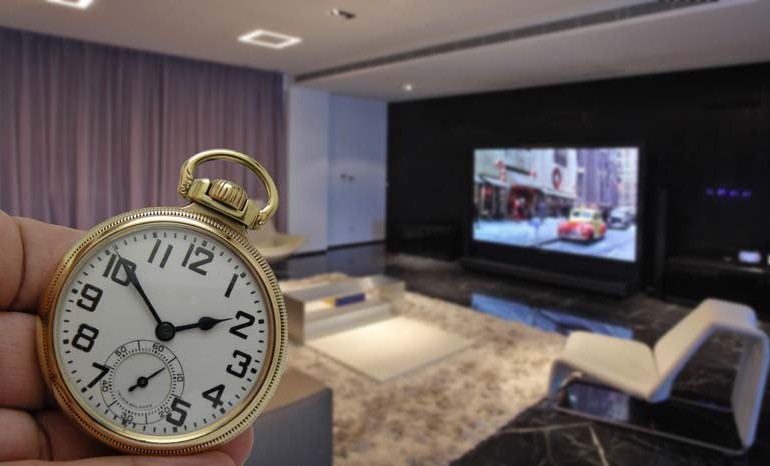Upgrading Speakers to Improve Your Home Theater
I think it’s safe to say that at some point in your adventures you’ll get the bug to start upgrading speakers in your home theater. Rarely does anyone actually purchase their final set of speakers right away—unless you came into some money and spent an awful lot of time researching at the onset. No, for most it’s a progression from the affordable to the excellent. So how do you know when to upgrade your speakers? We’ve got some ideas. Follow along and see if you agree with them or not.
Upgrading Speakers When They Are the “Weakest Link”
It doesn’t make much sense to me when people upgrade their speakers, and they still use an entry level AV receiver or a DVD player to watch movies. There are a lot of places where an upgrade will transform your home theater experience. Other times, it will just reveal more problems. Make sure you’ve covered the basics:
- Make Sure You Have a Decent Subwoofer
If you have a decent pair of bookshelf speakers that you’d like to upgrade, but you’re still using that 6.5-inch sub that came with your home theater in a box—you may want to hold off. Upgrading speakers, including that subwoofer, may present you with an entirely new listening experience that will far outweigh a simple front speaker upgrade. Subwoofers provide a tangible, “felt” aspect of home theater that cannot be obtained any other way. With a nice subwoofer, your movie-watching experience will be much more theatrical in nature. If you want even bass across all your seats, consider buying a second sub. It’ll make a big difference! - Do You Have Surround Speakers?
If you’re upgrading your front speakers but you haven’t yet added surrounds in the back of your room, get those set up first. Experiencing true surround sound from discrete surround speakers will forever change how you watch movies at home. There’s just nothing like it. I always recommend making sure you’ve got a complete, enveloping 5.1 or 7.1 system before embarking on individual speaker upgrades. You won’t regret the decision. One exception to this rule is if you are going to use your old front speakers AS the surrounds. In that case—purchase away! - Are You Watching in HD?
I’ve seen people upgrade parts of their AV system while still watching DVDs and while still using other standard definition content. Sometimes it’s an older television (though that’s rare these days). More often, it’s the incorrect cable that isn’t getting them the high-definition content they should be enjoying. Some people also never bothered upgrading their cable or satellite system to HD after they purchased a new TV. In either case, the idea is that upgrading to HDTV will provide a huge improvement in your movie-watching experience. Do that before you upgrade any other hardware. If you’re still using a DVD player, realize that Blu-ray players now cost as little as $50. - Got HD? What About HDR?
Sure, you’ve got HD. Maybe you even bought a 4k display. But are you taking advantage of HDR? HDR and Dolby Vision make your picture look even more realistic by providing more colors and brighter highlights. If you have a newer display, consider upgrading to an Ultra Blu-ray player to take advantage of the HDR versions of new (and some legacy) releases. HDR will take your viewing experience to the next level (much more than 4k or 8k will).
Upgrading Speakers for Aesthetics
I might get myself in trouble here, but I know of several people who upgraded their speakers for aesthetic reasons. I have some strong opinions on that. While, in principle, I think aesthetics is a bad basis for an upgrade, there are tons of finish and color options for speakers and lots of products on the market to satisfy nearly anyone. That means that if you do feel the need to lean in a particular direction or color for your speakers, you can easily do so.
Where I tend to take issue is when people try to make their speakers disappear altogether. That includes replacing floorstanding or bookshelf speakers with tiny “cube” speakers that take up no space at all and can even be mounted to the ceiling. Typically, these aren’t going to yield the same kind of midrange clarity and definition as a larger pair of speakers. Those manufacturers may have worked well within the limits of the laws of physics—but they still can’t break them.
Upgrading Speakers When You Have the Money
Come on, this is just practical. It’s hard to think about upgrading your speakers when you don’t have the cash to follow through. As a result, there’s no reason to think about or plan your upgrade until you’re heading towards a place in your life when you can actually execute. Plan too early, and you’ll find that you simply have to do your research all over again when it’s time to make that final plunge. I know a lot of people who use their tax refund to purchase new audio gear (these are largely single people, mind you, but still—it works).
Others will save up for that big purchase and squirrel away money from side jobs or weekly “allowance” funds. Either way is an excellent idea, but one thing is for certain—it’s never a good idea to finance a home theater upgrade. Wait until you’re ready to plop down the money. Then go big or go home—remember, movie tickets cost $10 or more these days. Think of all the money you could save! 😉 Two people visiting the theaters once a week with soda and snacks and that adds up to…$1.4 million a year? I’m not good with math.
Upgrading Speakers When You Know It Will Help
Finally—and this is the hardest to understand—start upgrading speakers in your home theater when you know it will help. What I mean by that is this: Don’t upgrade your speakers just for the sake of doing it. Spend some time to understand why you are doing the upgrade. Larger speakers aren’t necessarily better—they just play lower. If you have a nice subwoofer, and you spend the time to calibrate it and properly place it, there’s no reason why a bookshelf speaker system can’t sound just as good as a pair of tower speakers.
When you’re upgrading speakers, make sure it’s for the right reasons. That means you want to ensure you’re getting a better quality of speaker. You want better build quality, a step up in the quality of components, and most certainly a significant increase in midrange clarity—where the majority of your listening will occur.
Listen for clarity, low distortion (when your speakers sound like they are playing underwater or when everything sounds harsh), and dynamic range (can they play both loudly and softly with detail?). You want your speakers to be able to sound as big as the movie you’re watching, or the dynamic music you’re listening to—but not reveal themselves too much. You want to listen to the sound—not the speakers. Speakers that boldly proclaim “Here I am!” aren’t what you’re after. Instead, you want a pair of speakers that melt into the room while they fill that room with beautiful music or the spacious environment of the show you’re focusing on.
And you thought upgrading speakers simply entailed firing up your browser and placing an order!







2 years ago. Switched from some classic Large Advents to some it-ty bitty Klipchs. Yep, a downgrade, but the wife is happy.
As much as I hate to admit it, aesthetics matter!
Still have my Advent Legacy II’s from the ’80’s, and still love them.
You can even buy a refoaming kit for $25 and restore them to perfection. I’ve seen these speakers sold used for under $50.
Just bought a new center channel Martin Logan motion 8 and new front left and right definitive sm55 loudspeaker they are ran through a Yamaha extra-760 I previously had a Bose acoustimass 6 3 5.1 system now I will use to fill in my needs to setup for a atmos speaker setup?